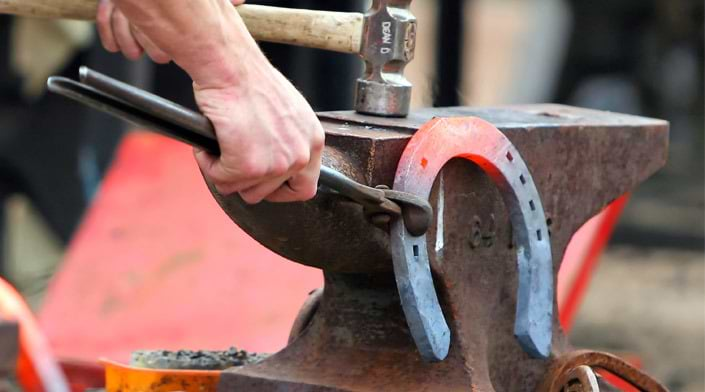
Horses have played a vital role in transportation for thousands of years. In fact, horseshoes boast a long history, but when were they first created and why?

© MLA Photography / Adobe Stock
Why horses need shoes
Once people started using horses for transportation, they discovered that a horse would be faster and more efficient if it had protection for its feet. While foot protection appears to be the main reason that horseshoes were invented, some experts suggest that the metal shoes also served well as a weapon during battles.
Horseshoe origins
While it's not entirely certain who invented the horseshoe, many experts credit the Romans for this creation. The Roman poet, Catullus, talks about a mule losing its shoe in the 1st century BC.
Early horseshoes were made from hides and woven with foliage by Asian horsemen. While these shoes were very primitive, it's thought they helped soothe sore hooves and offer the horse some protection against injury.
After the first century, horsemen fitted makeshift leather and metal sandals over the hooves of a horse and fastened them with leather straps. These were known as hipposandals. Although they worked satisfactorily on dry terrain, they offered little protection when it was wet or in colder climates.
It's not clear who first nailed shoes to a horse's feet, although by 1,000 AD it became common practice throughout Europe. While it might seem cruel to nail shoes to a horse's hoof, the fact that the hoof is dense and insensitive means that shoes can be secured with nails without causing distress to the animal.
Early nailed horseshoes were made using bronze, and had a scalloped outer rim consisting of six nail holes. Eventually, this increased to eight nail holes and the shoes were made from heavier materials.
Iron became a common metal used to make horseshoes, and these shoes actually became a valuable commodity. In 12th century England, iron horseshoes were often traded like a currency, or used to pay off debts.
Folk stories surrounding horseshoes also started to arise around this time, and they became synonymous with good luck. Horseshoes would serve as talismans to ward off the devil.
By the 13th and 14th centuries, horseshoes became much more commonplace and could be bought ready-made. Larger shoes were also made to accommodate bigger horses.
Around the 16th century, the person who fitted horseshoes became known as a farrier. This term has Latin origins, but the French verb 'ferrier' also refers to the process of shoeing horses.
As the Industrial Revolution dawned, the introduction of machinery in 1800 allowed horseshoes to be produced on a scale not seen before. It was recognised that the correct fitting of horseshoes was important, and so classes teaching skills to would-be farriers started to emerge.
Horseshoes today
Interestingly, horseshoes today have not changed significantly compared to those produced over 100 years ago. Hoof pads from yesteryear were made from rubber, while light aluminium shoes are still popular today. For those horses that have a tendency to throw shows, toe clips continue to enjoy popularity.
Horseshoes come in all shapes and sizes, and although they are mostly made from metal, synthetic materials may also be used. Most horseshoes are nailed to the horse by a professional farrier, although occasionally they may be glued on.
The material used to make a horseshoe often depends on the role of the horse. Horses that need a long-wearing shoe for sports such as show jumping or polo are often fitted with steel shoes, while those used for racing often wear lighter, aluminium types. Some shoes have a protrusion at the toe or heel to improve grip and movement.
Shoes certainly help to protect a horse's feet, but for further protection for you and your horse, you can find a great range of high-quality equestrian products available at specialist provider, Griggs Equestrian.





